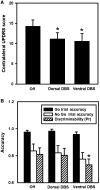Mapping Go-No-Go performance within the subthalamic nucleus region
- PMID: 20855421
- PMCID: PMC2995882
- DOI: 10.1093/brain/awq256
Mapping Go-No-Go performance within the subthalamic nucleus region
Abstract
The basal ganglia are thought to be important in the selection of wanted and the suppression of unwanted motor patterns according to explicit rules (i.e. response inhibition). The subthalamic nucleus has been hypothesized to play a particularly critical role in this function. Deep brain stimulation of the subthalamic nucleus in individuals with Parkinson's disease has been used to test this hypothesis, but results have been variable. Based on current knowledge of the anatomical organization of the subthalamic nucleus, we propose that the location of the contacts used in deep brain stimulation could explain variability in the effects of deep brain stimulation of the subthalamic nucleus on response inhibition tasks. We hypothesized that stimulation affecting the dorsal subthalamic nucleus (connected to the motor cortex) would be more likely to affect motor symptoms of Parkinson's disease, and stimulation affecting the ventral subthalamic nucleus (connected to higher order cortical regions) would be more likely to affect performance on a response inhibition task. We recruited 10 individuals with Parkinson's disease and bilateral deep brain stimulation of the subthalamic nucleus with one contact in the dorsal and another in the ventral subthalamic region on one side of the brain. Patients were tested with a Go-No-Go task and a motor rating scale in three conditions: stimulation off, unilateral dorsal stimulation and unilateral ventral stimulation. Both dorsal and ventral stimulation improved motor symptoms, but only ventral subthalamic stimulation affected Go-No-Go performance, decreasing hits and increasing false alarms, but not altering reaction times. These results suggest that the ventral subthalamic nucleus is involved in the balance between appropriate selection and inhibition of prepotent responses in cognitive paradigms, but that a wide area of the subthalamic nucleus region is involved in the motor symptoms of Parkinson's disease. This finding has implications for resolving inconsistencies in previous research, highlights the role of the ventral subthalamic nucleus region in response inhibition and suggests an approach for the clinical optimization of deep brain stimulation of the subthalamic nucleus for both motor and cognitive functions.
Figures



References
-
- Aron AR, Robbins TW, Poldrack RA. Inhibition and the right inferior frontal cortex. Trends Cogn Sci. 2004;8:170–7. - PubMed
-
- Baunez C, Humby T, Eagle DM, Ryan LJ, Dunnett SB, Robbins TW. Effects of STN lesions on simple vs choice reaction time tasks in the rat: preserved motor readiness, but impaired response selection. Eur J Neurosci. 2001;13:1609–16. - PubMed
Publication types
MeSH terms
Grants and funding
LinkOut - more resources
Full Text Sources
Medical

